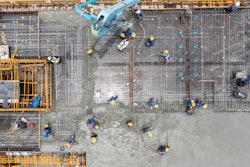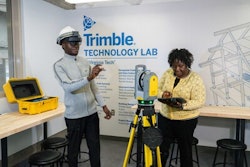
The Equipment Today team spoke with Elwyn McLachlan, sector vice president for Trimble Civil Solutions, about where the industry was in 2023 and what to look for in 2024 for the State of the Industry Report. This Q&A provides her insights.
What was the construction industry’s biggest challenge in 2023?
At our recent Trimble Dimensions user conference, we heard loud and clear from our customers that the industry’s biggest challenge has been and continues to be the labor shortage. The continued lack of workers is preventing employers across the construction sector from hiring the people they need to take on new projects, complete projects on time and grow their companies. Fortunately, technology can help offset some of these challenges by automating certain tasks and making workers more efficient and productive.
Are changes in the workforce, including retirements, affecting your company?
Retirements pose a challenge that’s different from the labor shortage in general because retiring workers take so much historical knowledge with them. Digitizing construction workflows can go a long way toward helping offset these challenges because important information can be stored in the cloud rather than stored in someone’s memory.
Companies that [use] technology to design, build and maintain construction assets are leveraging historical data for improved outcomes on the next job. That information is easily accessible to everyone on the team and future workers.
At the same time, younger workers entering jobs in construction are digital natives. They know their way around gaming consoles, touchscreens and apps, which makes their adoption of construction technology easy. Many of our customers tell us that young workers are seeking jobs with companies that are on the forefront of technology adoption, and that investing in technology like machine control and connected construction workflows provides a competitive advantage when it comes to hiring.
Is your company still experiencing fallout from the pandemic, including supply chain issues or other problems?
Despite all of the challenges caused by the pandemic, it actually served as a catalyst for the adoption of technology that helps people work more productively from afar. Many of the technology solutions Trimble provides helped contractors remain productive through the pandemic and are still delivering great value today because they help construction companies do the same work with fewer people needed on the jobsite. This includes solutions that connect the field and the office, help machine operators receive remote support and automate tasks so even beginner operators can work with accuracy and efficiency.
In what technological areas do you see the potential for the most innovation in 2024?
The construction industry is a hotbed of innovation right now with nearly unlimited potential when it comes to emerging technologies like AI, automation and robotics. These technologies all deliver a lot of promise for the future of construction, but for the next 12 months, I think the areas where innovation will actually deliver the most value are focused on making it easier for contractors to get the absolute most out of their technology investment. This includes innovation around the way owners and operators access, analyze and use data to make better decisions and run their businesses more profitably as well as a continued push toward jobsite connectivity, which is the cornerstone for field-to-office workflows, task automation and overall better site management.
What innovations or improvements do you anticipate in construction equipment in 2024?
I expect to see an increasing reliance on technology year after year, well into the future. Because of this, I think we will continue to see more equipment coming directly from the factory equipped with [different] technology and more equipment types coming factory-fit for aftermarket technology additions.
I also expect to see a continued, slow but steady march toward autonomy, with new task automation capabilities introduced and ongoing testing of autonomous solutions throughout 2024 and into the future. Mixed fleets will still be the norm, and I know at Trimble we will continue our focus on developing technology solutions that work seamlessly with mixed fleets of equipment.
How are the Internet of Things, software and connectivity affecting your company specifically and the industry as a whole?
Construction connectivity is at the heart of what we do at Trimble, and we believe it is the way of the future. Software is changing the way we build roads, bridges, buildings and other assets and infrastructure. From enabling machine control, to connecting stakeholders across the construction continuum, to helping project owners more effectively operate and maintain their finished assets, software is transforming the construction industry. The ability to connect people, projects and machines and then use the data from those systems to make better business decisions offers unmatched potential for everyone in the construction lifecycle.
Do you expect the infrastructure bill to affect your business or your customers’ businesses? How, if you can explain further?
We are already seeing the infrastructure bill affect our customers’ businesses with an influx of road, bridge, highway, tunneling and other infrastructure-related projects. Trimble is well poised to help meet our customers’ needs on infrastructure projects, in particular, for multiple reasons.
First, we’re starting to see some departments of transportation (DOTs) requiring the use of the technology solutions we provide, such as machine control, digital twins and having project information in a common data environment. Second, public sector projects—and those vying for funding from the infrastructure bill, in particular—also tend to require a higher level of reporting, which our software enables. Third, our asset lifecycle management solutions connect people, processes and data across all lifecycle phases, which makes it easier for DOTs and other public sector owners to stay connected and coordinated with engineers, contractors, subcontractors and other stakeholders.
What will be the biggest challenge in 2024 for the industry?
Uncertainty about the economy could provide some challenges for the industry as we head into 2024, but I think the prolonged labor shortage will continue to be the biggest hurdle for the construction industry. For our customers, everything else pales in comparison to not having the people they need to either get the job done or take on more work. Fortunately, technology can help overcome this challenge.
One of our top priorities for 2024 is making it easy for construction firms to obtain and implement the technology they need and then get maximum value from it. For example, we now offer many of our solutions via a subscription model that automatically includes access to the latest Trimble technology. This kind of technology assurance means that all equipment is running the same version, so managers don’t have to worry about compatibility, and training and supporting staff are easier.
Are there any other insights looking toward 2024 that you’d like to share?
As we move into 2024, environmental sustainability will continue to be an important topic for the construction industry. In most cases, current construction processes still produce too much waste and [have an] environmental impact, both in the construction phase and once an asset is complete and moves into the operations phase. We know that technology can deliver measurable sustainability benefits, including a reduction in fuel consumption, carbon emissions and wasted materials.
Technology can also help increase the longevity of assets like roads, bridges and highways through better construction quality and more efficient asset maintenance. As we look toward 2024 and the future, the construction industry as a whole must be committed to ongoing innovation … to address environmental challenges effectively.



















